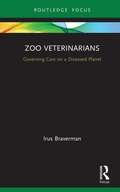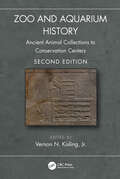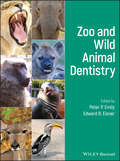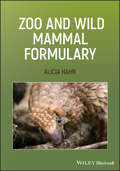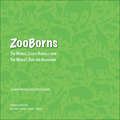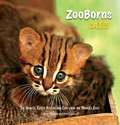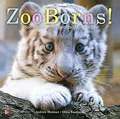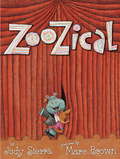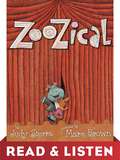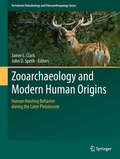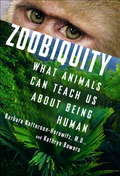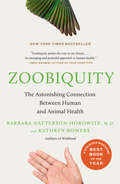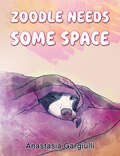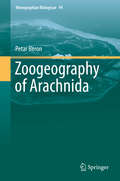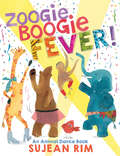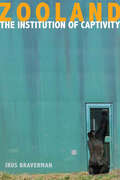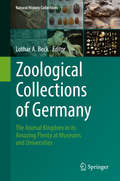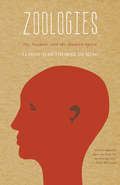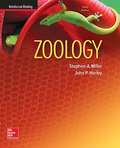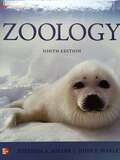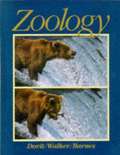- Table View
- List View
Zoo Vet: Adventures of A Wild Animal Doctor
by David TaylorIn this book, Taylor shares some of his experiences as he cares for exotic animals. Not all stories have happy endings, but all are heart-warming. This is an honest look at what it was like to be a zoo vet in the fifties and sixties.
Zoo Veterinarians: Governing Care on a Diseased Planet (Law, Science and Society)
by Irus BravermanDespite their centrality to the operation of contemporary accredited zoo and aquarium institutions, the work of zoo veterinarians has rarely, if ever, been the focus of a critical analysis in the social science and humanities. Drawing on in-depth interviews and observations of zoo and aquarium veterinarians in Europe and North America, this book highlights the recent transformation that has occurred in the zoo veterinarian profession during a time of ecological crisis, and what these changes can teach us about our rapidly changing planet. Zoo vets, Braverman instructs us with a wink, have "gone wild." Originally an individual welfare-centered profession, these experts are increasingly concerned with the sustainability of wild animal populations and with ecological health. In this sense, the story of zoo vets "going wild"—in their subjects of care, their motivations, and their ethical standards, as well as in their professional practices and scientific techniques—is also a story about zoo animals gone wild, wild animals encroaching the zoo, and, more generally, a wild world that is becoming "zoo-ified." Such transformations have challenged existing norms of veterinary practice. Exploring the regulatory landscape that governs the work of zoo and aquarium veterinarians, Braverman traverses the gap between the hard and soft sciences and between humans and nonhumans. At the intersection of animal studies, socio-legal studies, and Science and Technology Studies, this book will appeal not only to those interested in zoos and in animal welfare, but also to scholars in the posthumanities.
Zoo and Aquarium History: Ancient Animal Collections to Conservation Centers
by Vernon N. Kisling Jr.Wild animals have been housed in zoos and aquariums for 5,000 years, fascinating people living in virtually every society. Today, these institutions are at a new milestone in their history. This second edition of Zoo and Aquarium History takes the reader on a journey through the transition of private collections to menageries, to zoos, then zoological gardens, and more recently conservation centers and sanctuaries. Under the direction of Vernon N. Kisling, an expert in zoo history, an international team of authors has thoroughly updated the only comprehensive, global history of animal collections, menageries, zoos, and aquariums. The resulting book documents the continuum of efforts in maintaining wild animal collections from ancient civilizations through today, explaining how modern zoos have developed their mission statements around the core aims of conservation, education, research and recreation. This new edition pulls together regional information, including new chapters on zoological gardens of Canada, Latin America, China, Israel, the Middle East, and New Zealand, along with the cultural aspects of each region to provide a foundation upon which further research can be based. It presents a chronological listing of the world's zoos and aquariums and features many never-before published photographs. Sidebars present supplementary information on pertinent personalities, events, and wildlife conservation issues. The original Appendix has been expanded to include over 1,200 zoos and aquariums, providing an invaluable resource. This is an extensive, chronological introduction to the subject, highlighting the published and archival resources for those who want to know more.
Zoo and Wild Animal Dentistry
by Edward R. Eisner Peter P. EmilyZoo and Wild Animal Dentistry is the first book to offer a comprehensive reference to oral pathology and dental therapy in captive and wild exotic animals. Comprehensive in scope, the book is authored by noted experts on the topic who cover dental care for a broad range of species with an emphasis on oral health. Designed as a practical resource for treating exotic animals, the book is filled with instructive photographs and illustrations that clearly depict pathologies and demonstrate techniques. The book draws on the editors’ and contributors’ years of experience with exotic animals to offer a reliable resource to the history of veterinary dentistry, information on the evolution of teeth, practical dental therapeutics, and oral descriptions for each of the more than three hundred species included in the book. Zoo and Wild Animal Dentistry covers a wide range of zoo and wild species, including cats, bears, primates, dogs, raccoons, weasels, hyenas, marsupials, herbivores, edentates, sea mammals, birds, reptiles, and more. This important resource: Offers a comprehensive reference to oral pathology and dental therapy in captive and wild animals Highlights oral health to promote overall health Includes information on the most recent advances in the field Contains a groundbreaking resource for the dental care of exotic animals Written for zoo and wildlife caretakers and veterinarians, veterinary dentists, veterinary technicians, and veterinary students, Zoo and Wild Animal Dentistry is a practical resource that has information for the dental care of a wide range of animal species that are all too often neglected.
Zoo and Wild Mammal Formulary
by Alicia HahnZoo and Wild Mammal Formulary offers fast access to authoritative dosing information for drugs used in more than 35 zoo and wild mammal groups, including marsupials, bears, and elephants. Taking an easy-to-use tabular format, the book is organized by taxa, with drug doses sorted by type and alphabetically arranged in every chapter. Clear and comprehensive, the book offers dosages for all important drugs, including antibiotics, antifungals, anesthetics, analgesics, and more. Each dose is referenced with a journal or textbook source, including the number of animals in the study where available, making it easy to find trusted information. Offers essential drug information for a wide range of zoo and wild mammals in an easy-to-consult format Provides dosing amounts for all important drugs, including antibiotics, antifungals, anesthetics, and analgesics Includes dosages for over 35 mammal groups, including marsupials, bears, and elephants Takes a tabular approach for quick reference Makes it easy to find a referenced dose for these animals, eliminating time spent searching through other sources Zoo and Wild Mammal Formulary is an essential reference for all veterinarians seeing zoo and wild animal patients, including zoo and wildlife veterinarians, veterinary specialists, and veterinary students.
Zoo in the Sky: A Book of Animal Constellations
by Jacqueline MittonLittle Bear and the Great Bear in the Northern Sky; the scaly dragon winding his long tail; the Great Dog chasing the Hare in the Southern Sky; all are beautifully rendered in Christina Balit's vibrant art, studded with shiny stars, which perfectly illustrates Jacqueline Mitton's rich text.
ZooBorns
by Andrew Bleiman Chris EastlandZooBorns showcases the newest and cutest animal babies from accredited zoos and aquariums around the world. With interesting animal facts and background stories on the featured babies, ZooBorns illustrates the connections between zoo births and conservation initiatives in the wild.
ZooBorns Cats!
by Andrew Bleiman Chris EastlandZooBorns showcases the newest and cutest animal babies from accredited zoos and aquariums around the world. With interesting animal facts and background stories on the featured babies, ZooBorns illustrates the connections between zoo births and conservation initiatives in the wild.
ZooBorns!: Zoo Babies From Around The World (Elementary Core Reading)
by Andrew Bleiman Chris EastlandNIMAC-sourced textbook
ZooZical
by Marc Brown Judy SierraWinter weather is keeping children from visiting the zoo. So the animals are out of sorts--listless, grumpy, and no longer fun. All except two little friends, a very small hippo and a baby kangaroo. Their hip-hopping, toe-tapping, and rap-rocking soon has the other animals joining in the hip-aroo beat. "Racoons danced in pairs, baboons danced in troops, and snakes joined the dancers as live hula-hoops." Children's favorite songs get a funny new spin--seals bark out "The seals on the bus go round and round"--as the animals create their very own musical.Young readers and listeners will be amazed and delighted at how the animals chase the winter doldrums by getting along as friends, pooling their talents, and pushing themselves to new heights. After all, these are the same clever animals who learned to read in Judy Sierra's and Marc Brown's Wild About Books, an award-winning New York Times #1 bestselling picture book. ZooZical is sure to inspire some "can do" fun in kindergarten and primary grades.From the Hardcover edition.
ZooZical: Read & Listen Edition
by Judy SierraWinter weather is keeping children from visiting the zoo. So the animals are out of sorts—listless, grumpy, and no longer fun. All except two little friends, a very small hippo and a baby kangaroo. Their hip-hopping, toe-tapping, and rap-rocking soon has the other animals joining in the hip-aroo beat—now brought to life with audio narration in this Read & Listen edition. "Raccoons danced in pairs, baboons danced in troops, and snakes joined the dancers as live hula-hoops." Children's favorite songs get a funny new spin—seals bark out "The seals on the bus go round and round"—as the animals create their very own musical.Young readers and listeners will be amazed and delighted at how the animals chase the winter doldrums by getting along as friends, pooling their talents, and pushing themselves to new heights. After all, these are the same clever animals who learned to read in Judy Sierra's and Marc Brown's Wild About Books, the award-winning New York Times #1 bestselling picture book. ZooZical is sure to inspire some "can do" fun in kindergarten and primary grades.This ebook includes Read & Listen audio narration.
Zooarchaeology and Modern Human Origins: Human Hunting Behavior during the Later Pleistocene
by John D. Speth Jamie L. ClarkRecent genetic data showing that Neanderthals interbred with modern humans have made it clear that deeper insight into the behavioral differences between these populations will be critical to understanding the rapid spread of modern humans and the demise of the Neanderthals. This volume, which brings together scholars who have worked with faunal assemblages from Europe, the Near East, and Africa, makes an important contribution to our broader understanding of Neanderthal extinction and modern human origins through its focus on variability in human hunting behavior between 70-25,000 years ago--a critical period in the later evolution of our species.
Zoobiquity
by Kathryn Bowers Barbara N. HorowitzEngaging science writing that bravely approaches a new frontier in medical science and offers a whole new way of looking at the deep kinship between animals and human beings. Zoobiquity: a species-spanning approach to medicine bringing doctors and veterinarians together to improve the health of all species and their habitats. In the tradition of Temple Grandin, Oliver Sacks, and Neil Shubin, this is a remarkable narrative science book arguing that animal and human commonality can be used to diagnose, treat, and ultimately heal human patients. Through case studies of various species--human and animal kind alike--the authors reveal that a cross-species approach to medicine makes us not only better able to treat psychological and medical conditions but helps us understand our deep connection to other species with whom we share much more than just a planet. This revelatory book reaches across many disciplines--evolution, anthropology, sociology, biology, cutting-edge medicine and zoology--providing fascinating insights into the connection between animals and humans and what animals can teach us about the human body and mind.
Zoobiquity: What Animals Can Teach Us About Health and the Science of Healing
by Kathryn Bowers Barbara Natterson-HorowitzIn the spring of 2005, cardiologist Barbara Natterson-Horowitz was called to consult on an unusual patient: an Emperor tamarin at the Los Angeles Zoo. While examining the tiny monkey's sick heart, she learned that wild animals can die of a form of cardiac arrest brought on by extreme emotional stress. It was a syndrome identical to a human condition but one that veterinarians called by a different name--and treated in innovative ways. This remarkable medical parallel launched Natterson-Horowitz on a journey of discovery that reshaped her entire approach to medicine. She began to search for other connections between the human and animal worlds: Do animals get breast cancer, anxiety-induced fainting spells, sexually transmitted diseases? Do they suffer from obsessive-compulsive disorder, bulimia, addiction? The answers were astonishing. Dinosaurs suffered from brain cancer. Koalas catch chlamydia. Reindeer seek narcotic escape in hallucinogenic mushrooms. Stallions self-mutilate. Gorillas experience clinical depression. Joining forces with science journalist Kathryn Bowers, Natterson-Horowitz employs fascinating case studies and meticulous scholarship to present a revelatory understanding of what animals can teach us about the human body and mind. "Zoobiquity" is the term the authors have coined to refer to a new, species-spanning approach to health. Delving into evolution, anthropology, sociology, biology, veterinary science, and zoology, they break down the walls between disciplines, redefining the boundaries of medicine. Zoobiquity explores how animal and human commonality can be used to diagnose, treat, and heal patients of all species. Both authoritative and accessible, offering cutting-edge research through captivating narratives, this provocative book encourages us to see our essential connection to all living beings.
Zoodle Needs Some Space
by Anastasia GargiulliZoodle is a happy dog; she loves her family and her ball. But when it’s time to go for a walk, Zoodle doesn’t like it at all! She is afraid of many things, some that wouldn’t scare you or me. She feels so afraid that she shows her teeth, in the hope of making the scary thing leave. She knows people don’t understand her when she speaks, because she doesn’t use words like you and me. How can we help her feel safe? Let’s learn about her fears and how she speaks, to make Zoodle and dogs like her feel safer in the street.
Zoofari
by Amanda Bybee16-year-old Jaime Needham can't see anything at night, but she has a grand vision to protect the animals of the San Francisco Zoo from the people of her city. Three years after the death of her mother, a veterinary scientist, Jaime is learning to care for Giraffes who have developed a super virus. She helps to form a similar Plan of Enrichment that saved the Bison of Golden Gate Park from extinction. In exchange for her service, Jaime is given the opportunity for a trial nightglow lens implant to restore her night vision. 21-year-old Spence, Jaime's supervisor from South Africa, is a zoologist conducting behavior research on human and animal interaction. He has constructed human structures which selected study members will enter inside of animal enclosures for leveled interaction, according to rank. When Spence's project is jeopardized, trouble escalates, until it is up to Jaime to act fast to get the key back in safe hands, and find her way, on her own terms, in order to prevent fatal consequences. "The study's test members had endured more than Mark Twain's 'coldest winter...a summer in San Francisco; ' they'd braved a trial fifteen-minute stay in the cold enclosures of lions, tigers, bears, elephants, monkeys, and zebras."
Zoogeography of Arachnida (Monographiae Biologicae #94)
by Petar BeronThis volume merges all geographical and paleogeographical data on all groups of the arachnofauna. The book features topics such as the ecological factors, climate and other barriers that influence the distribution of arachnida. It also elaborates on the characteristics of the distribution such as arachnida at high altitude (e.g. Himalaya), in caves, in polar regions and highlights differences between the arachnofauna of e.g. Mediterranean regions vs Central Europe, West African vs Indomalayan and more. Furthermore, amongst other topics the volume also includes chapters on the systems of arachnida, fossil orders, dispersal and dispersion, endemics and relicts, regional arachnogeography, cave and high altitude arachnida.
Zoogie Boogie Fever!: An Animal Dance Book
by Sujean RimA wild and wonderful cast of zoo animals boogie and zoogie the night away in this zany dance party celebration from watercolorist Sujean Rim! What do the animals at the zoo do when the gates close at night? They boogie until dawn! This bouncy, funny read-aloud is filled with an assortment of animals dancing to their own beat and celebrating their individuality. See the flamingos do the fandango, the elephants cha-cha-cha, and the little penguins break-dance as they all avoid being discovered by the zookeeper, and then turn the page to see everyone come together in one unforgettable conga line! Kids will be dancing and moving as they read along with Sujean Rim's irresistible cast of animal characters that fills every page. It all culminates in a surprise orientation shift that reveals an unforgettable finale!Featuring hilarious nods to dance movie classics like Flashdance, Dirty Dancing, and Dance Fever, this book is sure to make readers of all ages want to start grooving.
Zooland: The Institution of Captivity
by Irus BravermanThis book takes a unique stance on a controversial topic: zoos. Zoos have their ardent supporters and their vocal detractors. And while we all have opinions onwhatzoos do, few people considerhowthey do it. Irus Braverman draws on more than seventy interviews conducted with zoo managers and administrators, as well as animal activists, to offer a glimpse into the otherwise unknown complexities of zooland. Zoolandbegins and ends with the story of Timmy, the oldest male gorilla in North America, to illustrate the dramatic transformations of zoos since the 1970s. Over these decades, modern zoos have transformed themselves from places created largely for entertainment to globally connected institutions that emphasize care through conservation and education. Zoos naturalize their spaces, classify their animals, and produce spectacular experiences for their human visitors. Zoos name, register, track, and allocate their animals in global databases. Zoos both abide by and create laws and industry standards that govern their captive animals. Finally, zoos intensely govern the reproduction of captive animals, carefully calculating the life and death of these animals, deciding which of them will be sustained and which will expire. Zoolandtakes readers behind the exhibits into the world of zoo animals and their caretakers. And in so doing, it turns its gaze back on us to make surprising interconnections between our understandings of the human and the nonhuman.
Zoological Collections of Germany: The Animal Kingdom in its Amazing Plenty at Museums and Universities
by Lothar A. BeckProvides a timely compilation of German zoological collections.<P><P> Casts new light on endangered zoological collections and explores modern exhibition concepts.<P> Maximizes readers insight into the zoological collection network.<P> This book is devoted to the knowledge of up to 250 years of collecting, organizing and preserving animals by generations of scientists. Zoological Collections are a huge resource for modern animal research and should be available for national and international scientists and institutions, as well as prospective public and private customers. Moreover, these collections are an important part of the scientific enterprise, supporting scientific research, human health, public education, and the conservation of biodiversity. Much of what we are beginning to understand about our world, we owe to the collection, preservation, and ongoing study of natural specimens. Properly preserved collections of marine or terrestrial animals are libraries of Earth's history and vital to our ability to learn about our place in its future.<P> The approach employed by the editor involves not only an introduction to the topic, but also an external view on German collections including an assessment of their value in the international and national context, and information on the international and national collection networks. Particular attention is given to new approaches of sorting, preserving and researching in Zoological Collections as well as their neglect and/or threat. In addition, the book provides information on all big Public Research Museums, on important Collections in regional Country and local District Museums, and also on University collections.<P> This is a highly informative and carefully presented book, providing scientific insight for readers with an interest in biodiversity, taxonomy, or evolution, as well as natural history collections at larg
Zoologies: On Animals and the Human Spirit
by Alison Hawthorne Deming“Beautifully written essays” on animals, “the real and mythological, the ordinary and the exotic, the wild and the domesticated” (Publishers Weekly).Humans were surrounded by other animals from the beginning of time: they were food, clothes, adversaries, companions, jokes, and gods. And yet, our companions in evolution are leaving the world—both as physical beings and spiritual symbols—and not returning. In this collection of linked essays, Alison Hawthorne Deming examines what the disappearance of animals means for human imagination and existence. Moving from mammoth hunts to dying house cats, she explores profound questions about what it means to be animal. What is inherent in animals that both leads us to destroy and leads us toward peace? As human animals, how does art both define us as a species and how does it emerge primarily from our relationship with other species? The reader emerges with a transformed sense of how the living world around us has defined and continues to define us in a powerful way.“Beautifully written essays on animal and human behavior and biology . . . highly recommended for lovers of words and nature.” —Publishers Weekly“Human beings live in an age in which industrialization and mass extinction are facts of life. But as Deming suggests in this collection, the more people denude the planet of animals, the more diminished they become in spirit . . . Eloquent, sensitive and astute.” —Kirkus Reviews“Serpentine intellect and wry humor.” —Booklist
Zoology
by Stephen A. Miller John P. HarleyThe new 7th edition of "Zoology" continues to offer students an introductory general zoology text that is manageable in size and adaptable to a variety of course formats. It is a principles-oriented text written for the non-majors or the combined course, presented at the freshman and sophomore level. "Zoology" is organized into three parts. Part One covers the common life processes, including cell and tissue structure and function, the genetic basis of evolution, and the evolutionary and ecological principles that unify all life. Part Two is the survey of protists and animals, emphasizing evolutionary and ecological relationships, aspects of animal organization that unite major animal phyla, and animal adaptations. Part Three covers animal form and function using a comparative approach. This approach includes descriptions and full-color artwork that depict evolutionary changes in the structure and function of selected organ systems.
Zoology
by Stephen A. Miller John P. HarleyThe new 7th edition of "Zoology" continues to offer students an introductory general zoology text that is manageable in size and adaptable to a variety of course formats. It is a principles-oriented text written for the non-majors or the combined course, presented at the freshman and sophomore level. "Zoology" is organized into three parts. Part One covers the common life processes, including cell and tissue structure and function, the genetic basis of evolution, and the evolutionary and ecological principles that unify all life. Part Two is the survey of protists and animals, emphasizing evolutionary and ecological relationships, aspects of animal organization that unite major animal phyla, and animal adaptations. Part Three covers animal form and function using a comparative approach. This approach includes descriptions and full-color artwork that depict evolutionary changes in the structure and function of selected organ systems.
Zoology
by Robert Dorit Warren F. Walker Robert D. BarnesComprehensive, flexible and accessible, the text emphasizes evolution is at the very beginning in discussions of molecular and cell biology. A systems/classification organization and emphasis on "predictive value" reinforce the evolutionary theme.

